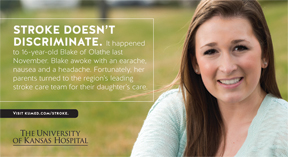 Editor’s note: We last updated Chronicle readers in January about the progress of Blake Ephraim, a 16-year-old member of Congregation Beth Torah who suffered a stroke in early November. May is National Stroke Awareness Month and Blake was featured in a campaign conducted by the University of Kansas Hospital. The following is an update of her story.
Editor’s note: We last updated Chronicle readers in January about the progress of Blake Ephraim, a 16-year-old member of Congregation Beth Torah who suffered a stroke in early November. May is National Stroke Awareness Month and Blake was featured in a campaign conducted by the University of Kansas Hospital. The following is an update of her story.
“Right now I’m looking at you, and I can’t believe/You don’t know, oh, oh/You don’t know you’re beautiful.”
Blake Ephraim had belted out those lyrics to One Direction’s “What Makes You Beautiful” too many times for her mother to count.
But last December, when Lisa Wilcox heard her daughter quietly sing every single word of her favorite song, it was not only reassuring, it was nothing short of a miracle.
Just a month before, Blake, an active 16-year-old junior varsity cheerleader at Olathe South High School, had suffered a stroke caused by cerebral venous sinus thrombosis.
It was a diagnosis her family never expected.
Stroke doesn’t discriminate
Blake’s symptoms started on a Friday morning with an earache. She went to school, and she cheered at the football game that night.
The next evening, however, her earache had progressed into a pounding, debilitating headache. Blake was inconsolable. Her parents rushed her to the emergency room. Doctors there found bleeding on her brain and transferred her to the Advanced Comprehensive Stroke Center at The University of Kansas Hospital. It’s one of the first in the nation — and the only one in the region — to receive this certification from The Joint Commission.
Here, Lisa Wilcox first heard the word “stroke” to describe what had happened to her daughter.
“My first reaction was that Blake had a cheer competition in three weeks,” Lisa said. “I just couldn’t process it. Stroke isn’t something that happens to 16-year-old girls. It was overwhelming.”
Expert stroke team was standing by
The Acute Stroke Response Team took the first steps to monitor Blake’s brain pressure, control the swelling and minimize the damage to her brain. Blake’s team was led by neurosurgeon Koji Ebersole, M.D., and neurointensivist Kathrin Husmann, M.D.
“The whole neuro ICU team — neurointensivists, specialized nurses, board-certified neurosurgeons — continuously monitor our patients,” said Dr. Husmann. “We can be at the patient’s bedside in moments to assess the situation and respond immediately. That makes a huge difference with stroke patients because time isn’t on our side.”
Because of that attention, Blake’s team quickly realized that medications and moderate measures weren’t doing enough to relieve the pressure on her brain.
Dr. Ebersole performed a decompressive craniectomy, a complex neurosurgical procedure in which part of the skull is removed to give the brain room to expand. With her brain pressure under control, the team worked on breaking up the clot.
A couple of days later, the doctors took her off the ventilator, and Blake said her first word, “Mom.”
Advanced care, amazing recovery
Blake still faced a long road to recovery. Her right side and right arm were weak, and her language skills were deficit. She spent nearly a month in a Nebraska rehabilitation facility working on physical, occupational and speech therapy. All the while she was motivated by the music of her favorite bands.
“I’d never been sick. I’d never had to ask anyone for help,” Blake said. “And here I was. I couldn’t figure out the words I wanted to say. I could only stand up. But quitting was never an option.”
Today, Blake is back in school and recently made the varsity cheerleading team. Her recovery has been an inspiration to both her classmates and the doctors on her care team.
“In no way did I anticipate how well she would do — a large part due to her amazing spirit and supportive family,” said Dr. Husmann. “It’s been exciting to be part of her care.”
Blake realizes she still has a lot of work to do, and she’ll improve with the support of family and friends at her side.
“The one great lesson I learned?” said Lisa. “If your child is having a stroke, get them to The University of Kansas Hospital. You want that stroke team helping your child from the very first second they possibly can.”
This article and the accompanying graphic is courtesy of The University of Kansas Hospital.



